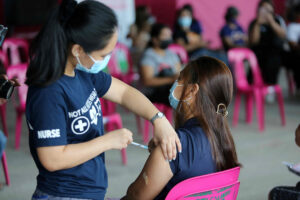THE AVERAGE daily coronavirus infections in the Philippines rose by 39% last week to 1,467 from a week earlier, according to the Department of Health (DoH), amid a fresh surge in cases caused by more contagious Omicron subvariants in China and Europe.
Infections on July 4 to 10 hit 10,271, while severe and critical cases reached 27, it said in a bulletin.
Of the 50 new deaths, one occured in May, three in February, and eight in January. The rest occured in the past two years.
DoH said 411 of 2,414 intensive care unit (ICU) beds had been used as of July 10, while 4,863 of 21,424 non-ICU beds were occupied. There were 555 severe and critical admissions.
Fredegusto P. David, a fellow at the OCTA Research Group, tweeted on Sunday night that the positivity rate in Metro Manila had risen to 10.9%, breaching the threshold set by the World Health Organization (WHO).
The infection rate should remain below 5% to keep coronavirus cases under control, according to the international agency.
On Monday, Mr. David told a televised news briefing Metro Manila’s reproduction rate had fallen to 1.49 from 1.6. The rate should ideally be below one.
Cases remained relatively low because Filipinos still have “a wall of immunity” after they were vaccinated against the coronavirus, he said.
OCTA earlier said that daily cases in the capital region could hit 1,000 or as high as 2,000 by mid- or late July.
Fewer than 20% of the Philippines’ target population have taken booster shots against the coronavirus, Rontgene M. Solante, a member of the government’s vaccine expert panel, told the same briefing.
Compare this with 50% in Vietnam, Singapore, Thailand and Malaysia, he pointed out.
“Our booster uptake is very low,” he said. “I think it’s high time that we mandate booster vaccination for the general population.”
The government should take into account the full implementation of face-to-face classes by November and return to office orders for workers, Mr. Solante said.
He said the country might already be facing a “weak surge” in infections as projected by OCTA, noting that the region’s positivity rate had increased.
“This is starting now [because] our positivity rate or the number of newly infected individuals has already increased.”
The government had fully vaccinated 71.1 million Filipinos as of July 10, while 15.3 million have received boosters.
The highly contagious Omicron subvariants known as BA.4 and BA.5 are driving a summertime surge in Europe after most coronavirus policies were done away with in spring and a more relaxed approach to the pandemic had become the norm during the warmer months, the New York Times reported last week, citing health officials.
Daily cases in Europe had risen to 57 per 100,000 as of Wednesday from 33 per 100,000 just two weeks earlier, according to the Center for Systems Science and Engineering at Johns Hopkins University. That is the sharpest increase — a rise of about 70% — of any region of the world over the same period.
China also faces a resurgence of outbreaks, with many of its cities reimposing lockdowns as authorities rushed to control cases of the more infectious Omicron variant that had become dominant in western countries.
Macau, which is undergoing its worst coronavirus outbreak yet, on Monday closed all its casinos for the first time in more than two years.
Authorities have ordered nonessential businesses, which include more than 30 casinos, to close for a week. The city has posted 1,526 infections since the middle of June, according to official figures.
Eleven Chinese cities were under full or partial lockdowns, affecting 114.8 million people, or 8.1% of the population, according to the Financial Times, citing to data released last week by Japanese investment bank Nomura.
BA.4 and BA.5 appear to be able to evade some antibodies from previous infections and vaccines, but research suggests they do not seem to cause a more severe disease. BA.5 is already dominant on its own among new US cases, according to federal estimates.
The coronavirus has sickened more than 560 million people worldwide and killed 6.4 million, according to the Worldometer website, citing various sources including data from the WHO. About 534 million people have recovered.
The United States had the most infections at 90.3 million, with a little more than 1 million deaths. It was followed by India with 43.6 million cases and 525,454 deaths, Brazil with 32.9 million infections and 673,659 deaths and France with 32.1 million cases and 150,017 deaths. — Norman P. Aquino and K.A.T. Atienza

